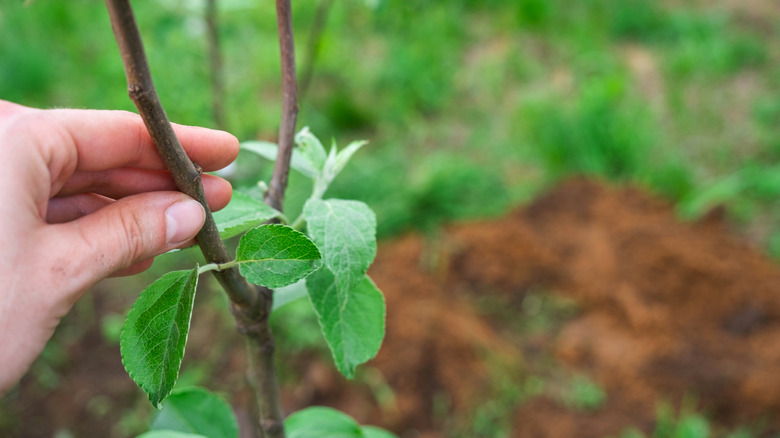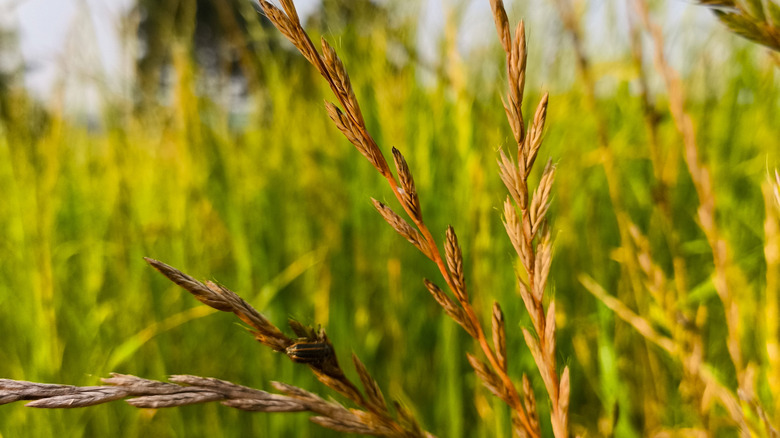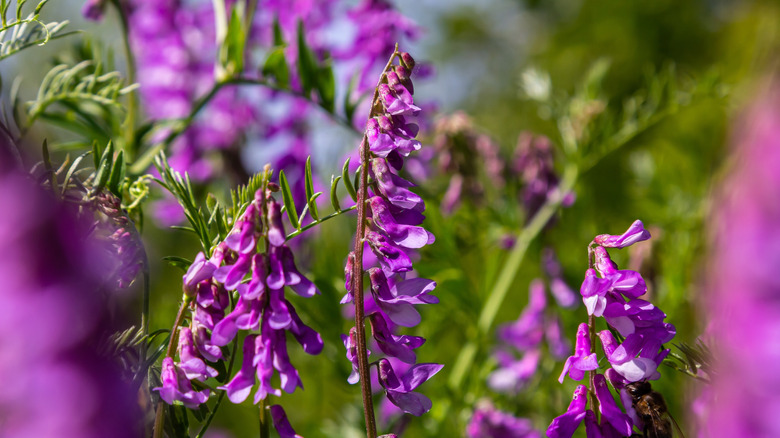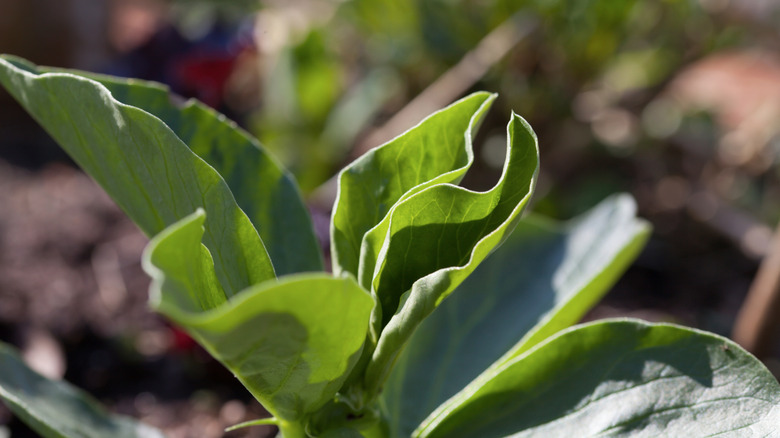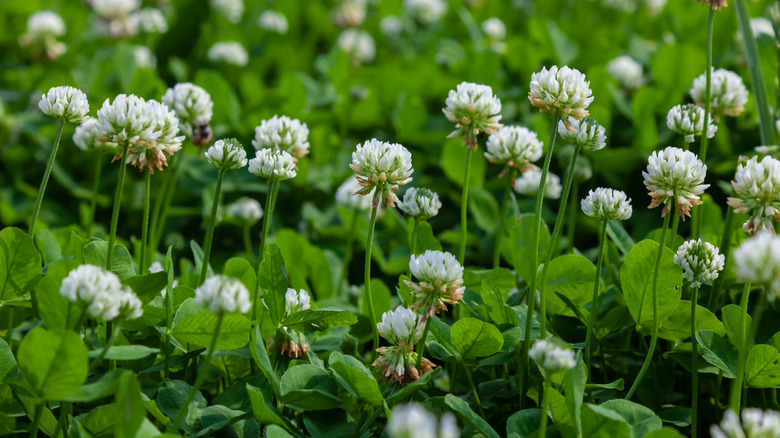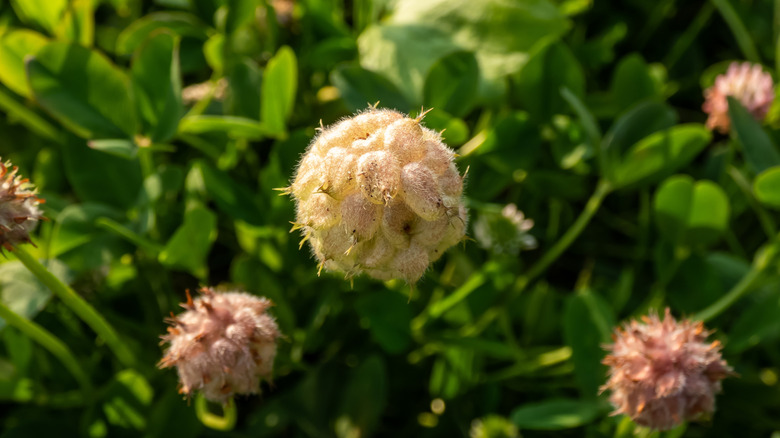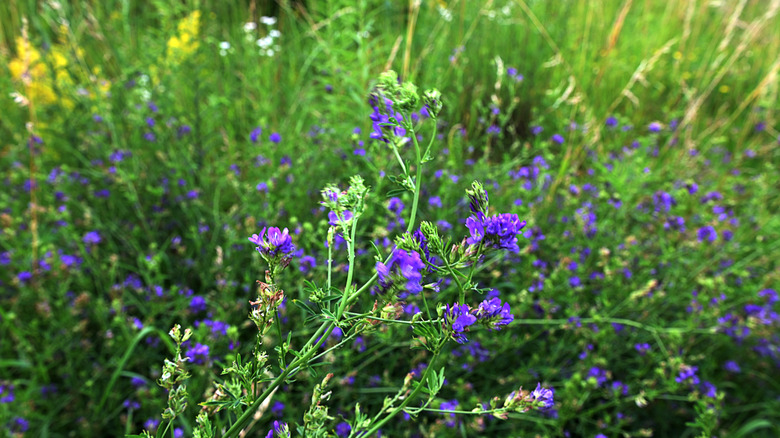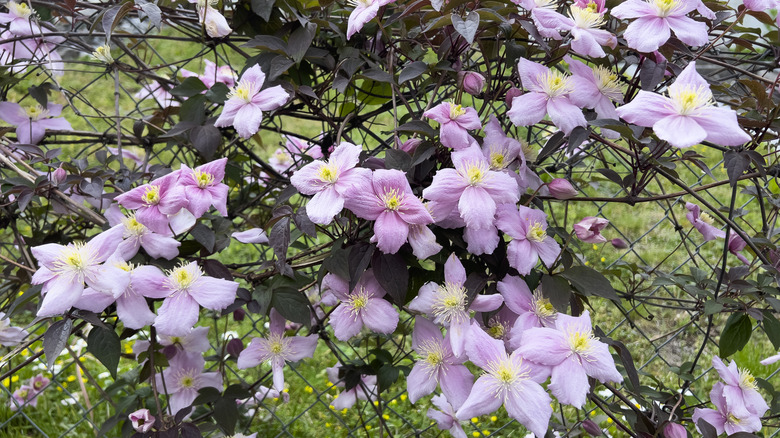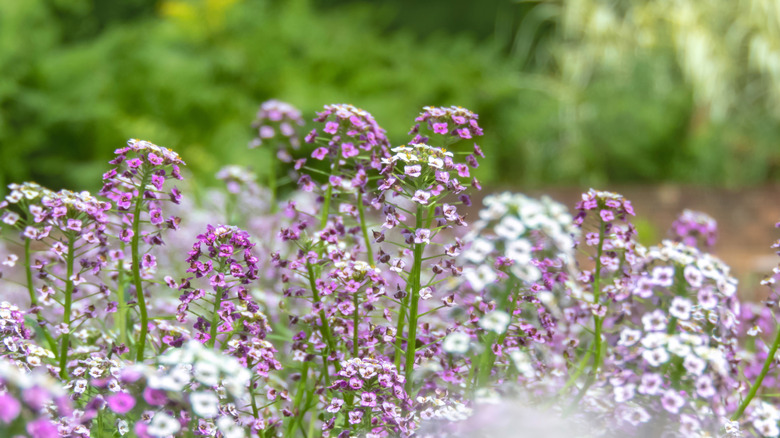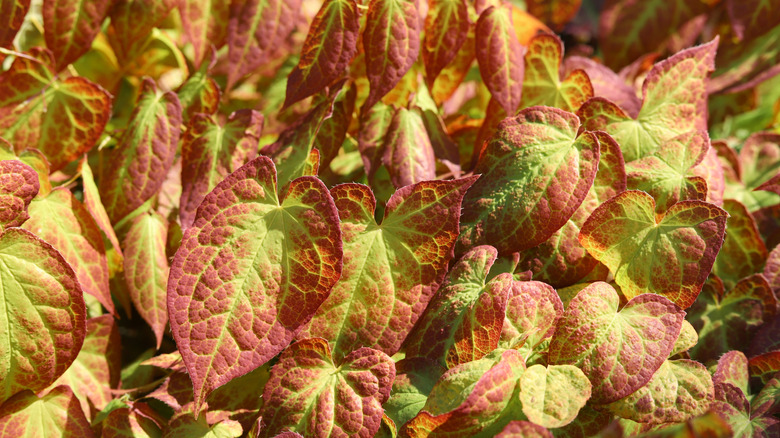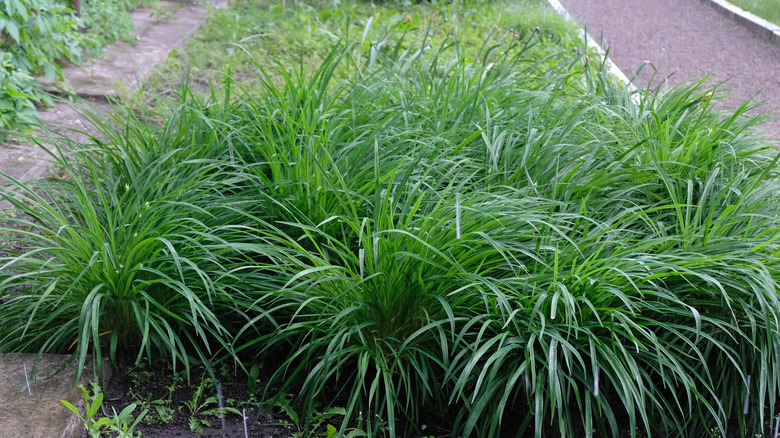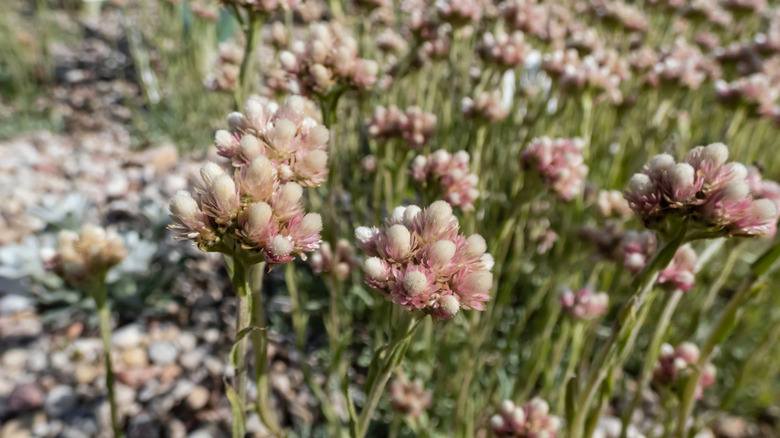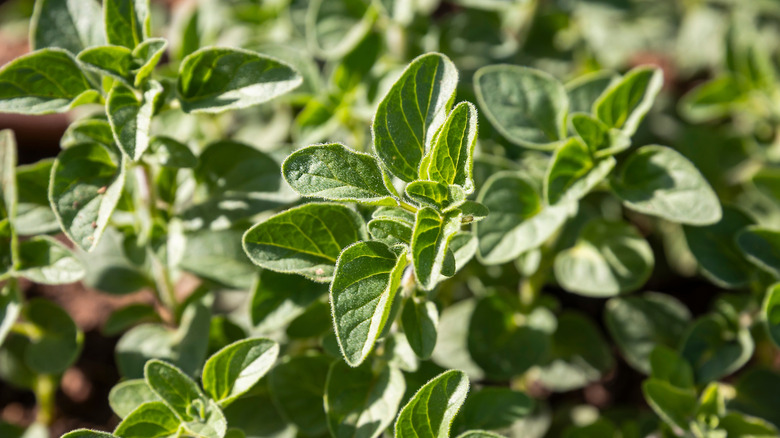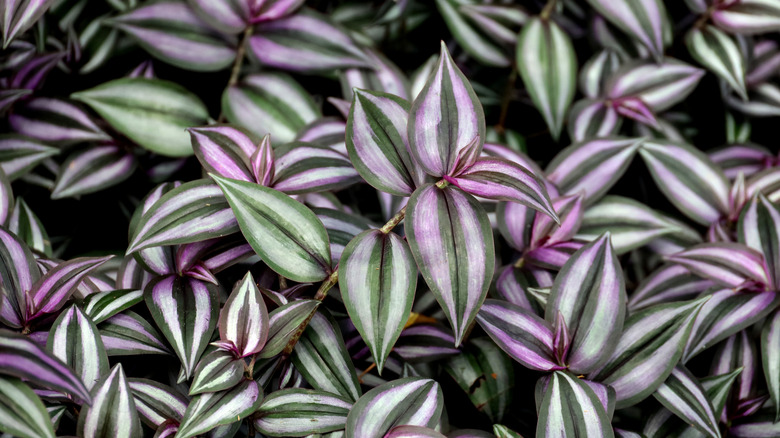The Best Types Of Ground Covers To Plant Around Fruit Trees
We may receive a commission on purchases made from links.
Fruit trees can take a lot of work to grow, especially during the first few years before they begin to fruit. If you want to cut your garden chores down, consider adding a few ground covers around your trees. Ground covers are not only pretty, but they're a workhorse of plant care, reducing weeds and keeping moisture in the soil. But not all ground covers are created equal and some do better as a neighbor to fruit trees than others.
So, if you're wondering what to plant around your apple, peach, or cherry trees, you've come to the right place, because we're breaking down 13 of the best ground covers specifically for fruit trees. From the low-maintenance options to some more unique plants that give your garden a little eye-candy appeal, we'll talk about what makes each one a good choice, so you can pick the perfect ground cover to help your fruit trees thrive.
Ryegrass (Lolium) helps deliver essential nutrients
Ryegrass (Lolium), particularly perennial ryegrass (Lolium perenne), makes an excellent ground cover for fruit trees. Its rapid germination and growth create a dense mat, effectively suppressing weeds that compete with fruit trees for nutrients and water. Ryegrass' roots also help stabilize the soil, preventing erosion and runoff, which is especially important on slopes. Plus, it's an excellent friend for nearby plants and trees because it helps reduce essential nutrient loss. A 2024 study published in Frontiers in Plant Science showed that ryegrass planted around citrus trees helped reduce nitrogen and potassium runoff by 42.53% and 49.23%, respectively. A different Frontiers in Plant Science study published in 2022 showed it had a similar benefit for apple trees, so it's probably safe to say that your fruit tree, whatever the species, might be happy to have a neighbor like ryegrass.
However, keep in mind that ryegrass is a very fast-growing grass seed and it can become a problem if you're not a vigilant gardener. To keep it in check you'll need to mow it regularly, ensuring it stays where it's supposed to and doesn't block airflow to the tree trunk. Also, give your fruit tree a little bit of space when planting ryegrass. Ryegrass' dense mat can lead to a rise in humidity, due to the lack of airflow around the soil, potentially increasing the risk of fungal diseases like crown rot on both the grass and your trees. To help mitigate this, consider mixing it with another ground cover to break up the density and plant at least 1 foot away from your tree's trunk.
Garden vetch (Vicia sativa) can fix soil nitrogen levels
Want something a little showier than a plain old grass? Give garden vetch (Vicia sativa) a go. This wildflower, which is actually in the legume family, not only looks great with its bright purple flowers, but it can help suppress spring weeds and is able to fix nitrogen imbalances in soil, ensuring your fruit trees get the right amount of macronutrients they need to produce lots of fruits. Plus, its blooms attract pollinators and beneficial insects that will prey on pests.
Unlike some other ground covers, garden vetch is also easy to manage, because it will die off after a mow or winter frost. That said, vetch can get weedy if it's allowed to self-seed and may begin to cling to your fruit trees' trunks so that it can climb. Plant your vetch in the fall and you may see a few bright winter blooms, but expect the full display during the spring. Once the blooms have just begun to wilt, cut the plant down to prevent self-seeding and replace it with a summer-loving ground cover, then replant in the autumn for year-round weed control.
Fava beans (Vicia faba) also help fix soil nitrogen levels
Fava beans (Vicia faba) rank as one of the best cover crops that will also suppress weeds in your garden, and are another excellent ground cover option around fruit trees. Like garden vetch, these plants are legumes, so they are able to fix nitrogen in the soil. Their deep taproots also break up compacted ground, helping ensure your fruit tree's roots get all the oxygen and water they need. Fava beans create lots of leafy growth that becomes nutrient-rich organic matter as they die off, which in turn can act as a natural fertilizer for your trees.
One problem you may face with a fava bean ground cover is dealing with Aphis fabae, better known as black bean aphids. These aphids adore fava beans, and while they can show an interest in fruit trees — there's a good chance they'll prefer the fava bean plants, which might even act like a trap crop. Luckily, there are lots of ways to attract good insects into your yard and garden to prey on the aphids and decimate their populations.
White clover (Trifolium repens) forms a short carpet and houses lots of beneficial bugs
Sometimes you just want a tried and true option. If that's the case, look no further than the white clover (Trifolium repens). As another member of the legume family, it's a champ for fixing nitrogen and it's a low-growing plant that behaves well around fruit trees — ideal if you like to rake or pick up fallen fruit and don't want them getting lost in a dense, bushier ground cover. Plus, it's awesome for attracting beneficial insects. A study conducted in the 1980s tested a variety of ground covers in apple orchards and found that white clover was one of the plants that supported the highest number of beneficial predatory insects. Talk about a winning reputation.
White clover sees mowing as a challenge and will respond to being mowed down by spreading even more aggressively, so don't do that. If you are worried about the invasive potential of clover (which is renowned for getting weedy), consider planting microclover instead. These petite white clover varieties have less aggressive growth habits, forming clumps rather than large mats. The easiest way to plant clover is via seed — and if you want to try microclover, Outside Pride sells their Perennial White MiniClover Seed packs on Amazon.
Strawberry clover (Trifolium fragiferum) is heat-tolerant and attracts beneficial insects
If you want a low-growing ground cover with a little pizzaz, give strawberry clover (Trifolium fragiferum) a try. It's also a legume, so it has those awesome nitrogen-fixing benefits, but is more heat tolerant than white clover, which makes it great for fruit trees in hotter climate zones. Strawberry clover also has an intricate root system that can dig almost 4 feet into the ground, making it moderately drought- and salt-resistant — another selling point for those growing fruit trees in hot or coastal conditions.
The aforementioned study that tested white clover also tested strawberry clover, finding it was neck and neck for its ability to attract the most beneficial insects to apple orchards. The main thing to consider if choosing strawberry clover for your fruit trees is that, while it's good in full sun, it can't tolerate shade, so only plant it if it has access to lots of sunshine (such as under well-groomed or dwarf fruit trees that don't have big, dense canopies). There are also some cultivars that aren't very cold-tolerant and may die in colder winters. If you live somewhere that gets heavy snow, avoid the 'Salina' and 'Palestine' strains and just opt for the straight T. fragiferum variety.
Alfalfa (Medicago sativa) helps increase soil organic matter
Alfalfa (Medicago sativa) is a powerhouse ground cover that fixes nitrogen and has deep roots that break up compacted soil. Plus, it's easily adaptable and is able to thrive in all 50 states of the U.S. The 2024 Frontiers in Plant Science study that tested ryegrass also tested alfalfa in citrus orchards, finding it was awesome for increasing the amount of organic matter in soil, as well as delivering much-needed nitrogen and urease, a beneficial enzyme found in plants that converts urea in the soil into ammonia and carbon dioxide.
So, what's the downside? Well, alfalfa can reach up to 3 feet in height if not mowed regularly, making it one of the taller ground covers. It's a bit of a resource hog that can compete with young saplings for water, so is best saved for gardens with more mature fruit trees. Also, it's a long-term commitment type of plant that's hard to get rid of, so make sure you actually like the idea of alfalfa before using it as a ground cover.
Mountain clematis (Clematis montana) makes a great ground cover that also smells amazing
Not every ground cover needs to be a bean, of course. For those who want something a little more ornamental, give mountain clematis (Clematis montana) a try. It's one of the best flowers to grow alongside citrus trees in the garden, thanks to its heavenly vanilla scent and flower color that complements citrus trees beautifully. But it's not just citrus trees that benefit from a little mountain clematis; all fruit trees are fans. Mountain clematis makes a great ground cover for fruit trees thanks to its ability to attract pollinators, its easygoing nature, and vining growth habit, which can suppress weeds. Clematis is particularly useful for sloped areas where its roots can help stabilize the soil and prevent erosion.
Mountain clematis likes to climb, though it can run on the ground as a vine. Just be aware that it may reach out for your tree's trunk if not pruned regularly. Overall, it's fairly easy to grow and does well in full sun or partial shade. It won't enjoy being waterlogged, so plant it in areas with well-draining soil.
Sweet alyssum (Lobularia maritima) attracts aphid predators
Sweet alyssum (Lobularia maritima) is another low-growing ornamental ground cover that can give fruit trees a little boost. While it's not a nitrogen fixer like others on this list, its ability to attract predatory insects that prey on fruit-specific pests makes it a favorite for fruit tree growers. The superstar predator that loves sweet alyssum in particular is the hoverfly, which preys on woolly apple aphids and Asian citrus psyllids. As you can tell by their names, both of these can wreak havoc on fruit trees, so planting sweet alyssum nearby almost guarantees a hoverfly will be on the way to take care of the infestation soon.
Sweet alyssum doesn't have many downsides to it, though it can be a little temperamental about its growing conditions. They need well-draining soil to thrive and to avoid developing powdery mildew. Additionally, sweet alyssum is sensitive to drought conditions, so only plant it if you can ensure it will receive good airflow and enough water. Alyssums are also annuals, so they will need to be replanted yearly, but may self-seed in the spring if they've survived the winter successfully.
Bicolor barrenwort (Epimedium x versicolor 'Sulphureum') grows quickly under tree canopies
If you want a ground cover that will give you a colorful landscape year-round, then you're going to love bicolor barrenwort (Epimedium x versicolor 'Sulphureum'). This ground cover is a shade-loving plant, and so will do well under the canopy of established (non-deciduous) fruit trees like avocados, and help to suppress weeds like perennial broadleafs and grasses — notorious for setting up shop around fruit trees — as close to the trunk base as possible. Plus, its color-changing leaves will keep your garden looking dynamic throughout the seasons: starting with a reddish hue in spring, then switching to a green in summer to let its cheerful yellow flowers take center stage, and back to reddish-brown in the fall.
Barrenwort is not fast spreading and unlikely to overtake other plants or become weedy. However, 'Sulphureum' does grow a little quicker than other varieties, making it a good choice if you're eager to establish some cover under your fruit trees. It will wilt in full sun and needs at least partial shade to do well, making it a ground cover to save for once your trees have matured and can protect it better. Also, you may want to shelter it from winter damage if you live in USDA Zones 1 through 4b, as it's only considered hardy starting in Zone 5a.
Pennsylvania sedge (Carex pensylvanica) flourishes under shady canopies and is drought-tolerant
If you want a lazy plant that doesn't need a lot of attention, consider Pennsylvania sedge (Carex pensylvanica). Pennsylvania sedge is a shade-loving ground cover that can also handle some direct sunlight. This makes it exceptionally well-suited to growing under the canopy of tall fruit trees — especially deciduous species that will expose any groundcover you grow underneath to both sun and shade. Its drought tolerance also ensures Pennsylvania sedge won't compete with your trees for resources. This is especially important if you're living somewhere that has restrictions on water usage, but you have water-hungry trees like avocado, peaches, or figs. Plus, it's a native plant to the U.S., making it one of the easier ground covers to keep in check. Finally, this isn't just a practical plant, it can look nice too, seeing as it is an ornamental grass. While it doesn't produce showy flowers, Pennsylvania sedge will create a lush carpet under your fruit trees, turning the area into a neat glade.
Since Pennsylvania sedge is a native plant, it's great for gardens that are in more naturalized settings, as it won't become invasive and is already well-adapted to most climates around the U.S. and Canada. However, it's worth mentioning that, while Pennsylvania sedge is considered an easygoing, adaptable plant, it can't tolerate heavy foot traffic. If you're worried about damaging it while walking around under your trees to harvest fruit, consider putting in a few stepping stones. Pennsylvania sedge also prefers areas with cooler climates, so it may not do as well in USDA Zones 9a through 13b.
Plantain pussytoes (Antennaria plantaginifolia) is perfect for low-water orchards
Plantain pussytoes (Antennaria plantaginifolia) is a charming native ground cover that's resilient and easygoing. This ground cover stays low and spreads via runners, forming a dense mat that outcompetes weeds. Plantain pussytoes are also drought-tolerant once established making them a great option for gardeners planting dragon fruit, pomegranate, olives, or other fruit trees that thrive in low-water gardens.
In addition to being able to thrive in poor soils, the foliage of pussytoes is one of our favorites, with its tufts of pink and white that resemble cat paws (hence the name). This plant prefers dry, rocky, sandy conditions and won't do well in soils that are rich in organic matter or consistently moist, so definitely don't plant plantain pussytoes under heavy feeders or tropical species like mango trees, as it won't appreciate the cushy conditions. The good news, though, is that they won't compete with your fruit trees for resources, leaving all of those yummy nutrients for the trees.
Oregano (Origanum) attracts predatory insects to protect fruit trees
Low-growing herbs like oregano (Origanium) make great ground covers that do double-duty as a functional culinary plant and weed suppressor. Not only do oregano plants attract pollinators to fruit trees, but they're also a popular landing spot among predatory insects that can prey on orchard-decimating pests. A 2023 study in the journal Insects planted hedgerows of different plants around orange orchards to see which were the most useful for getting rid of orchard pests. They found that oregano was one of the herbs that predatory insects from the Macrolophus genus (which love to eat soft-bodied insects like whiteflies and spider mites) were most attracted to. So, if you're worried about a pest outbreak, try planting some oregano and see if it ends up bringing friends along, too.
Origanium isn't one type of plant, but accounts for all 45 species of oregano, many of which are excellent ground covers thanks to their deer-resistance, drought-resistant, and tolerance to poor soils. However, they're not tolerant of acidic soils, humid conditions, or consistent moisture, so only plant them in areas with well-draining, neutral or slightly alkaline, soil. Also, keep in mind that not all oreganos have culinary uses; ornamental oregano (Origanum laevigatum) or dittany of Crete (Origanum dictamnus) are two popular ornamental-only cultivars while Italian oregano (Origanum x majoricum), 'True' oregano (Origanium vulgare), and sweet marjoram (Origanum majorana) are a few of the more popular culinary varieties.
Tradescantia zebrina is easy to grow around fruit trees
You may know the Tradescantia zebrina as wandering dude or inch plant. Common as houseplants, tradescantia zebrinas also make fantastic ground covers, thanks to how versatile they are and how they're able to tolerate most growing conditions easily, including both full sun and shade — a valuable trait if you have deciduous fruit trees. Their multi-colored leaves grow quickly and form a dense striped mat that can help to suppress turfgrass, which can compete with apple or other fruit trees for resources and inhibit their growth. Plus, the plant's low maintenance care needs make it a favorite for new and seasoned gardeners alike.
T. zebrina is native to Mexico, so it needs hotter temperatures, thriving best in USDA Zones 9a to 11b. If you live below 9a you can still use it as a ground cover for your fruit trees, just clip a few stems once temperatures drop below 65 degrees Fahrenheit and propagate them indoors until you're back into the warm spring months (they happen to be one of those indoor plants that can grow in water almost indefinitely). Tradescantias can be hubs for spider mites and aphids if you're not careful, so keep an eye on their foliage or mix in a few plants that attract predatory bugs to keep things clean. These plants do best in well-draining soil. If your tradescantia gets a little too leggy as a ground cover, cut it back — this will make its new growth bushier. Just take note, Tradescantia zebrina can become invasive in Florida and it's not recommended to plant it there.
